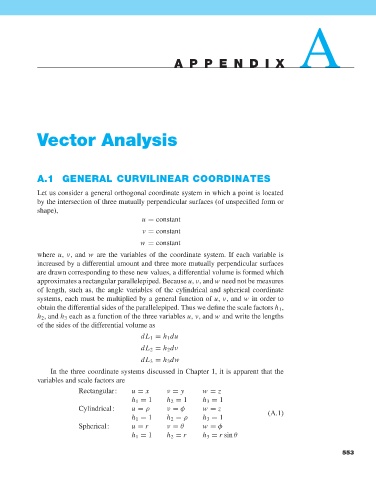Page 571 - Engineering Electromagnetics, 8th Edition
P. 571
A
APPENDIX
Vector Analysis
A.1 GENERAL CURVILINEAR COORDINATES
Let us consider a general orthogonal coordinate system in which a point is located
by the intersection of three mutually perpendicular surfaces (of unspecified form or
shape),
u = constant
ν = constant
w = constant
where u, ν, and w are the variables of the coordinate system. If each variable is
increased by a differential amount and three more mutually perpendicular surfaces
are drawn corresponding to these new values, a differential volume is formed which
approximates a rectangular parallelepiped. Because u, ν, and w need not be measures
of length, such as, the angle variables of the cylindrical and spherical coordinate
systems, each must be multiplied by a general function of u, ν, and w in order to
obtain the differential sides of the parallelepiped. Thus we define the scale factors h 1 ,
h 2 , and h 3 each as a function of the three variables u, ν, and w and write the lengths
of the sides of the differential volume as
dL 1 = h 1 du
dL 2 = h 2 dν
dL 3 = h 3 dw
In the three coordinate systems discussed in Chapter 1, it is apparent that the
variables and scale factors are
Rectangular: u = x ν = y w = z
h 1 = 1 h 2 = 1 h 3 = 1
Cylindrical: u = ρ ν = φ w = z
h 1 = 1 h 2 = ρ h 3 = 1 (A.1)
Spherical: u = r ν = θ w = φ
h 1 = 1 h 2 = r h 3 = r sin θ
553

